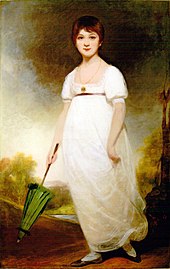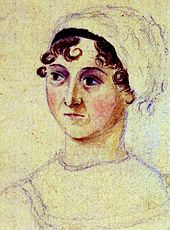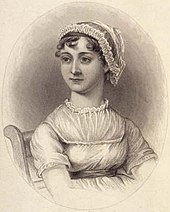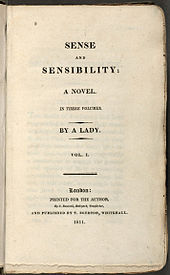Jane Austen
Jane Austen (born December 16, 1775 in Steventon , Basingstoke and Deane , † July 18, 1817 in Winchester ) was a British writer from the time of the Regency , whose main works Pride and Prejudice and Emma are among the classics of English literature .
Life
Jane Austen was born in 1775 in the rectory in Steventon, Hampshire, the seventh of eight children. Her father William George Austen (1731-1805) was a clergyman there. Her mother was Cassandra Austen, née Leigh (1739-1827). Jane had six brothers and an older sister who she was very close to. Jane Austen's only portraits are two color drawings by her sister Cassandra (1773–1845). Her brothers Francis William (called Frank; 1774-1865) and Charles John (1779-1852) served in the Royal Navy , where they both made it to the rank of admiral .
The family was well educated and well-read, so that the young Jane Austen received comparatively good support for her time as a girl and enjoyed a relatively comprehensive education. She had free access to her father's library and began her first literary steps at the age of twelve. Between 1787 and 1793 she wrote three volumes with short prose pieces, short novels, theater pieces and fragments that dealt extremely satirically with the literary and social conventions of the time. The first versions of her later novels were also written in Steventon between 1792 and 1799.
Since her father encouraged her interest in literature at an early age, she came into contact with a large number of well-known works at a young age. Her main focus was on the publications of William Cowper , Alexander Pope , Henry Fielding and George Crabbe , which she also cited in her works. The novel culture of the time was also closely followed by Jane Austen and her family. For example, the name of 20-year-old Jane Austen is on the subscription list of Fanny Burney's Camilla (1796).
In 1801 Jane Austen moved to Bath with her parents and her unmarried sister , where she lived until 1806. Little is known about this period in her life, as almost all letters from this period have been lost or destroyed by family members. Since Jane Austen was critical of the move to Bath from the start, it can be assumed that she was not very happy there. Also, she probably did little writing during this time. Only the fragment of the novel The Watsons is usually assigned to this period.
After the death of her father in 1805, Jane Austen, her mother and her sister first moved to Southampton with their brother Francis and his wife , where they lived until 1809. In 1809 they moved with their friend Martha Lloyd to Chawton, where their brother Edward (1767-1852), who had been adopted by a wealthy uncle, made a small country house available to them on his estate in Chawton. Jane Austen lived there until her death and revised, wrote and published all of her novels. Today this house is a small museum dedicated to the author.
Jane, like her sister, never married; in 1802 she had rejected a marriage proposal from Harrison Bigg Wither, who was six years her junior. As an established novelist, she lived in relative seclusion and eventually fell seriously ill at the age of 40. It is now believed that she suffered from adrenal insufficiency , the cause of which was unknown at the time and for which there was therefore no treatment. She traveled to Winchester with her sister Cassandra on May 24, 1817 to seek healing, but died there on July 18 and was buried on July 24 in Winchester Cathedral.
plant
Jane Austen published anonymously throughout her life; the books always bore the author's statement “by a lady”, even if the author's identity became more and more an open secret over time.
Early work
Jane Austen began her first literary endeavors with short prose and plays, mostly witty satires and parodies . The youth work has remained fragmentary and gives an insight into the literary roots and artistic development of the author. These early works were not fully published until the 1950s. Only about half of them have been translated into German so far, including the works Three Sisters , The History of England and Catherine .
Jane Austen wrote her first novels between the ages of 19 and 22, but they were only published 15 to 20 years later or posthumously. In 1809 Austen edited her manuscript Elinor and Marianne from 1796. In 1811, the novel was finally published under the title Sense and Sensibility (Eng .: understanding and feeling ) as her debut work under the pseudonym "by a lady". Pride and Prejudice (Eng .: pride and prejudice ), which followed in 1813, was the first draft from 1797 originally entitled First Impressions and was revised by Austen in 1811. Northanger Abbey (Eng: The Abbey of Northanger ) from 1798 to 1799 was revised by Austen in 1802, but did not appear until 1817 after her death. The epistolary novel Lady Susan from 1794, which Austen expanded to include a conclusion in 1805 , was also published posthumously in 1870 .
Austen's novels are determined by the “courtship plot”, which was very popular in literature at the time. The focus is on young women from the upper rural bourgeoisie, the "gentry", who recognize themselves after various difficulties and learning processes and marry the man they love.
At that time, a good marriage was the only acceptable way for a young woman of the “ gentry ” to secure a respectable position in society. Otherwise, like Jane Austen herself, she was dependent on the benevolence and generosity of wealthy relatives for life. All three novels deal with the conflict between the main characters to fulfill this socially imposed “duty” and still enter into an emotionally and humanly satisfactory marriage. As in all of her works, the author's main purpose of this framework is to uncover, caricature and criticize social, human and societal peculiarities.
In addition, the fragment of the novel The Watsons , which Austen probably began in 1804, but never completed, comes from this creative period . The fragment was published in 1871. In July 2011, the manuscript was auctioned at Sotheby's for £ 993,250 , the oldest contained manuscript by Jane Austen's hand thus reaching three times the estimate.
Late work
The three novels Mansfield Park , Emma and Persuasion (Eng .: persuasion or Anne Elliot ) were all published immediately after their creation, they form the “mature” work of Austen. Persuasion appeared posthumously as Jane Austen died a few months after completing the novel. In these three works, too, a young woman is always at the center of each plot, which always ends with the protagonist's wedding . However, the heroines and the situations in which they find themselves are markedly different from those of the three earlier works. Jane Austen also takes up socio-political issues more and more clearly.
Fanny Price from Mansfield Park (written 1811–1813) is a niece of the landlord who is accepted into his family and grows up there. In this regard, she is the most dependent of all Austen heroines and to this day one of the most controversial. In Mansfield Park , Jane Austen finds unusual political echoes that go beyond purely bourgeois social criticism. B. when Fanny Price asks her uncle about the origin of his wealth, namely the slave trade, and the assembled family falls silent in "deadly silence".
The main character of the same name in Emma (written in 1814) is the first young woman in Austen's novels who is not dependent on a good marriage for financial reasons. She is a wealthy, independent heiress who interferes in the private affairs of others and only realizes at the very end that she was wrong in all of her assumptions about the affairs of the heart of others, including her own.
In Persuasion (written 1815–1816) Jane Austen varied the initial situation. Anne Elliot is a well-to-do woman in her late twenties, similar to Emma, who years ago, under the influence of her family and friend, decided against the man she loved. In the course of the plot they meet again and gradually discover and reveal their mutual, unchanged feelings for one another.
Jane Austen condenses the plot compared to the first three novels. The events are almost exclusively portrayed from the point of view of the heroine, in Emma it goes so far that the readers never leave Highbury, Emma's place of residence.
Literary meaning

Jane Austen's novels go beyond the “romantic love story” and have achieved a cultural status similar to that of William Shakespeare's comedies in English-speaking, especially British, culture . In her linguistic virtuosity and economy, Austen has often been compared to the playwright by literary criticism.
Jane Austen's main talent was her astute observation, which she used to target human nature and social interactions . One of the groundbreaking stylistic developments is the spoken word that was introduced as a literary stylistic device at the end of the 18th century and was decisively further developed by Jane Austen.
Thematically, she initially orientated herself on the tradition of the moral novel, which was very popular at the time (e.g. by Fanny Burney , Maria Edgeworth ). Austen, however, raised this genre far beyond the boundaries of the time. Almost from the start, her literary and linguistic style has been classified as trend-setting by making the structural requirements of a modern form of communication between text and reader the subject of a conscious and planned writing process.
reception
Her works, especially Emma , are often praised as formally perfect, while the modern reception is constantly bringing to light new perspectives on Jane Austen's sharp commentary on the situation of young single women of the “gentry” (the upper middle class) in England in the early 19th century . The reception of her works was quite good at the time of publication. German and French translations of some of her works were published during her lifetime. Since then, the recognition given to her work has only increased; today she is considered one of the greatest English-speaking authors.
The first to publicly and extensively praised Austen's work was Walter Scott , who wrote a four-page essay for a literary magazine on the occasion of Emma's publication in 1816 - an extraordinary recognition at the time, especially since the genre of the novel has long been considered inferior, unimportant or even It was considered “immoral” and literarily ambitious women moved in a social gray area. He particularly emphasized the accuracy of observation, the linguistic elegance and the perfect mastery of the means in her works. Other literary figures also praised Austen's work (e.g. Robert Louis Stevenson and Rudyard Kipling , who even wrote a short story called "The Janeites"). Charlotte Brontë and Mark Twain , for example, expressed negative criticism . Brontë was too mundane and too coolly observing the realistic novels of Austen; she criticized the lack of passion that characterized her own works. Twain criticized the social decency, which seemed to him too Christian-moral. He said a library that was lacking their novels would make a good library out of one that didn't have any books in it.
With the beginning of the Victorian Age , Jane Austen's novels went out of style. In 1879 her nephew James-Edward Austen-Leigh published the first biography - "A Memoir of Jane Austen", which consisted of family memories and a few quotes from letters. He tried to adapt her image to the more conservative tastes of the time, which is certainly a reason for the extremely different views and approaches of biographers towards her person to this day. The publication of the biography triggered a new wave of interest in Jane Austen's novels, and shortly afterwards a collection of the letters she had received appeared, which also met with great interest. Jane Austen's sister Cassandra destroyed most of the letters that had left her before her death, so that the collection only allows a very limited view of Jane Austen's personality. Overall, the sources are very poor, as only around 160 of an estimated 3,000 letters have survived.
In the first half of the 20th century, Austen's work a. a. by Virginia Woolf's literary essays popular again, there was the first film adaptations of novels.
Since the 1990s, the popularity of Jane Austen's work has once again experienced a high point, not least due to the television adaptations of her novels, which are very popular in England and beyond, and some lavish cinema productions.
Numerous works inspired by Jane Austen's novels have been created to this day (e.g. Joan Aiken wrote several novels based on Austen's models). Helen Fielding adopts themes from Pride and Prejudice in Bridget Jones - Chocolate for Breakfast . In 2011, PD James published Death Comes to Pemberley, a crime novel based on Jane Austen's characters, which immediately became a bestseller. For the film adaptation of Bridget Jones , Colin Firth was cast as Mark Darcy, who had already played Mr. Darcy in the BBC series for Pride and Prejudice . The film Clueless - What Else! with Alicia Silverstone transfers the story of Emma into the Beverly Hills of the present.
In 2007 the film Becoming Jane (Beloved Jane) was released , which is an imaginary portrait of the life of Jane Austen, played here by Anne Hathaway .
There are festivals in Bath and Louiville Jane Austen.
Portrait on 10 pound note
In July 2013, Bank of England Governor Mark Carney announced that from 2017 a portrait of Jane Austen would be featured on the ten pound note . It was put into circulation on the 200th anniversary of death.
Works
Novels
- 1811: Sense and Sensibility (Sense and Sensibility) . Dt Alternative title: Sense and Sensibility
- 1813: Pride and Prejudice (Pride and Prejudice)
- 1814: Mansfield Park
- 1816: Emma
- 1817: Northanger Abbey (Northanger Abbey)
- 1817: Persuasion (Persuasion) dt Alternative title:. Anne Elliot or seduction
- 1871: Lady Susan (written around 1794) epistolary novel
Fragments
- 1870: The Watsons ( The Watsons , created around 1804)
- 1925: Sanditon (created 1816)
Youth works
Austen's early works in the English-speaking world were first published in 1988 as part of a complete edition by Oxford University Press and expanded in 1993. The collection includes the works:
- Frederic & Elfrida
- The history of England (The History of England)
- Jack & Alice
- Edgar & Emma
- Henry and Eliza
- The Adventures of Mr. Harley
- Sir William Mountague
- Memoirs of Mr. Clifford
- The Beautifull Cassandra
- Amelia Webster
- The Visit
- The mystery
- Three Sisters (The Three Sisters)
- A beautiful description
- The generous curate
- Ode to pity
- Love and Friendship (Love and Freindship)
- A Collection of Letters
- The female philosopher
- The first act of a comedy
- A Letter from a Young Lady
- A tour through Wales
- A valley
- Evelyn
- Catharine (Catharine, or the Bower)
Published in German:
- Love and Friendship - Three Sisters - Catharine. Manesse Verlag, Zurich 1994, ISBN 3-7175-4031-9 .
- The history of England illustrated with a foreword by Antonia S Byatt. Luxbooks, Wiesbaden 2009, ISBN 978-3-939557-57-9 .
-
The three sisters and other youth works. Insel-TB (Inselverlag), Frankfurt / Main and Leipzig 2000, ISBN 3-458-34398-9 .
- Lesley Castle
- A collection of letters
- Catharine or the arbor
- Draft for a novel
- Evelyn, Frederic and Elfrida
- Jack and Alice
- Edgar and Emma
- Henry and Eliza
- The adventures of Mr. Harley
- The beautiful Cassandra
- The visit
Letters
- My dear Cassandra! Selected letters . Translated from English and provided with an afterword by Ingrid von Rosenberg (= Ullstein Taschenbuch , Volume 30312: Die Frau in der Literatur ). Ullstein, Frankfurt am Main 1993, ISBN 3-548-30312-9 .
- I am impatient. Letters to Cassandra . Selected, translated from English and provided with an afterword by Ursula Gräfe . Insel Taschenbuch 3444, Frankfurt am Main 2013, ISBN 978-3-458-35144-3 .
Audio books
- Jane Austen: The Complete Works . Complete readings. Translated from the English by Ursula and Christian Grawe , read by Eva Mattes , Argon Verlag, Berlin 2017, ISBN 978-3-8398-9340-1 (contains reason and feeling , pride and prejudice , Mansfield Park , Emma , Northanger Abbey , persuasion , Lady Susan ).
- The Hessian Broadcasting plans from 2019 all the novels of Jane Austen bring out new as radio plays, Northanger Abbey has already been published.
literature
bibliography
- Detlef Münch: Bibliography and review of the German-language editions of Jane Austen 1822 - 2005 . Dortmund: Synergen 2005. ISBN 3-935634-43-9
General
- Deidre Le Faye: Jane Austen and her time . Berlin: Nicolai 2002. ISBN 3-87584-447-5
- Christian Grawe : "Darling Jane". Jane Austen, a biography . Reclam, Stuttgart 2010. ISBN 978-3-15-020206-7
- Christian Grawe: Jane Austen's novels. A literary guide. Stuttgart: Reclam 2015. ISBN 978-3-15-020380-4
- Park Honan: There is Happiness! Jane Austen and her time . Artemis & Winkler, Düsseldorf 2009. ISBN 978-3-538-07267-1
- Felicitas von Lovenberg : Jane Austen: A portrait . Frankfurt am Main: Insel-Verl. 2007. ISBN 978-3-458-34999-0
- Reimer Jehmlich: Jane Austen . Darmstadt: Wissenschaftliche Buchgesellschaft 1995. (Income from research. 286). ISBN 3-534-08797-6
- Elsemarie Maletzke : Jane Austen: A biography . btb, Munich 2009. ISBN 978-3-442-73780-2
- Wolfgang Martynkewicz : Jane Austen . Rowohlt, Reinbek near Hamburg 1995. ISBN 978-3-499-50528-7
- Jon Spence: Beloved Jane: The Story of Jane Austen . Insel, Frankfurt am Main 2007. ISBN 978-3-458-35012-5
Individual representations
- Annegret Schrick: Jane Austen and the female model biography of the 18th century, a structural and ideology-critical investigation into the central figure in Jane Austen . Trier: WTV 1986. (Dissertation Bochum [1986]). ISBN 3-922031-31-5
- Michael Suk-Young Chwe: Jane Austen. Game theorist . Princeton University Press 2014
Filmography
Film adaptations of the novels (selection)
see also: List of film adaptations of Jane Austen's works
- 1940: Pride and Prejudice (Pride and Prejudice) - Director: Robert Z. Leonard (with Greer Garson , Laurence Olivier )
- 1971 Persuasion - Director: Howard Baker (with Ann Firbank, Bryan Marshall )
- 1972 Emma - Directed by John Glenister (with Doran Goodwin, John Carson)
- 1980: Pride and Prejudice - Director: Cyril Coke (with Elizabeth Garvie, David Rintoul)
- 1980: Jane Austen in Manhattan - Director: James Ivory (with Anne Baxter , Robert Powell )
- 1983: Mansfield Park - Director: David Giles (with Sylvestra Le Touzel, Nicholas Farrell)
- 1985: Sense and Sensibility - Director: Rodney Bennett (with Irene Richard, Tracey Childs)
- 1987: Northanger Abbey - Director: Giles Foster (with Katharine Schlesinger, Peter Firth )
- 1995: Pride and Prejudice (Pride and Prejudice) - Director: Simon Langton (with Colin Firth , Jennifer Ehle )
- 1995: Jane Austen's Seduction (Persuasion) - directed by Roger Michell (with Amanda Root , Ciarán Hinds )
- 1995: Sense and Sensibility (Sense and Sensibility) - Director: Ang Lee (with Emma Thompson , Kate Winslet , Hugh Grant , Alan Rickman )
- 1995: Clueless - what else! (Clueless) - Director: Amy Heckerling (with Alicia Silverstone , Brittany Murphy , Paul Rudd and Breckin Meyer ).
- 1996 Emma - Directed by Douglas McGrath (with Gwyneth Paltrow , Jeremy Northam , Ewan McGregor )
- 1996: Emma - Directed by Diarmuid Lawrence (with Kate Beckinsale , Mark Strong )
- 1999: Mansfield Park - Director: Patricia Rozema (with Frances O'Connor , Jonny Lee Miller , Alessandro Nivola )
- 2000: Kandukondain Kandukondain (Indian adaptation of Sense and Sensibility ) - Director: Rajiv Menon (with Tabu , Aishwarya Rai )
- 2003: Pride and Prejudice - Director: Andrew Black (with Kam Heskin, Orlando Seale)
- 2004: Liebe Indian (Bride and Prejudice) - Director: Gurinder Chadha (with Aishwarya Rai , Martin Henderson )
- 2005: Pride and Prejudice (Pride and Prejudice) - Director: Joe Wright (with Keira Knightley , Matthew Macfadyen , Judi Dench )
- 2007: Persuasion - Director: Adrian Shergold (with Sally Hawkins , Rupert Penry-Jones )
- 2007: Northanger Abbey - Directed by Jon Jones (with Felicity Jones , JJ Feild )
- 2007: Mansfield Park - Director: Iain B. MacDonald (with Billie Piper , Blake Ritson)
- 2008: Sense and Sensibility (Sense and Sensibility) - Director: John Alexander (with Hattie Morahan , Charity Wakefield , Dan Stevens , David Morrissey )
- 2008: If Jane Austen Knew (Lost in Austen) - four-part British television film, adaptation of Pride and Prejudice
- 2009: Emma - Director: Jim O'Hanlon (with Romola Garai )
- 2011: From Prada to Nada (2011) (with Camilla Belle and Alexa Vega)
- 2011: Jane Austen's Sense and Sensibility (Scents and Sensibility) - Director: Brian Brough (with Ashley Williams , Marla Sokoloff , Brad Johnson )
- 2016: Love & Friendship (feature film based on the letter novel Lady Susan), director: Whit Stillman , with Xavier Samuel , Kate Beckinsale and others
- 2020: Emma - Director: Autumn de Wilde
Biographical films
- 2007: Beloved Jane (Becoming Jane) - Director: Julian Jarrold (with Anne Hathaway , James McAvoy , Maggie Smith , Julie Walters )
- 2008: Miss Austen Regrets - Directed by Jeremy Lovering (with Olivia Williams , Samuel Roukin, Greta Scacchi , Imogen Poots )
Web links
- Literature by and about Jane Austen in the catalog of the German National Library
- Works by and about Jane Austen in the German Digital Library
- Jane Austen. In: FemBio. Women's biography research (with references and citations).
- Jane Austen in the Internet Speculative Fiction Database (English)
- Newspaper article about Jane Austen in the 20th century press kit of the ZBW - Leibniz Information Center for Economics .
- Jane Austen Friends website
- www.bibliomania.com Original texts and study editions (English)
- Austen novels online at Project Gutenberg u. a. (English)
- Works by Jane Austen in the Gutenberg-DE project
- Jane Austen Center in Bath ( Memento of August 27, 2004 in the Internet Archive )
- Jane Austen wax figure unveiled on YouTube at the Jane Austen Center in Bath in English.
- Jane Austen House in Chawton
- www.pemberley.com (English)
- Website of the North American Jane Austen Society (English)
- Jane Austen in the database of Find a Grave (English)
- Pronunciation of the name Jane Austen on Forvo.com
- What did Jane Austen see?
Individual evidence
- ^ Elsemarie Maletzke: Jane Austen , p. 161
- ^ Elsemarie Maletzke: Jane Austen , pp. 281, 294 f.
- ^ Ddp ( German dispatch service ): High proceeds for an early work by Jane Austen . In: Neue Zürcher Zeitung . No. 165 . Zurich July 18, 2011, p. 34 .
- ^ Mansfield Park. Chapter 21 (Part II, Chapter 3)
- ↑ Gerd Birkner. A Woman of Importance: Jane Austen's novels - context and structure of effects, Hannover: Wehrhahn, 2015
- ^ Christian Grawe: "Darling Jane", Jane Austen - A biography . Philipp Reclam jun. Stuttgart, Stuttgart 2010, ISBN 978-3-15-020206-7 , pp. 256 .
- ↑ Deirdre Le Faye: Jane Austen: A Family Record. 2nd edition Cambridge University Press, Cambridge 2003, ISBN 0-521-53417-8 .
- ↑ Jane Austen Festival. Retrieved August 13, 2018 (UK English).
- ^ About Us - The Jane Austen Society of Louisville, Kentucky. Accessed August 13, 2018 .
- ↑ spiegel.de: Ten pounds for Jane Austen , [1]
- ↑ Jane Austen is now on Britain's 10 pound note . In: ABC News . September 14, 2017 ( net.au [accessed August 13, 2018]).
- ↑ Northanger Abbey Podcast at hr2-kultur
| personal data | |
|---|---|
| SURNAME | Austen, Jane |
| BRIEF DESCRIPTION | English writer |
| DATE OF BIRTH | December 16, 1775 |
| PLACE OF BIRTH | Steventon , Hampshire |
| DATE OF DEATH | July 18, 1817 |
| Place of death | Winchester |







